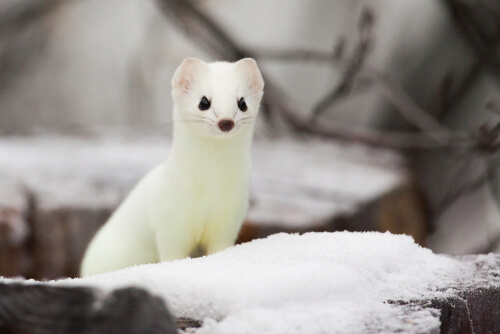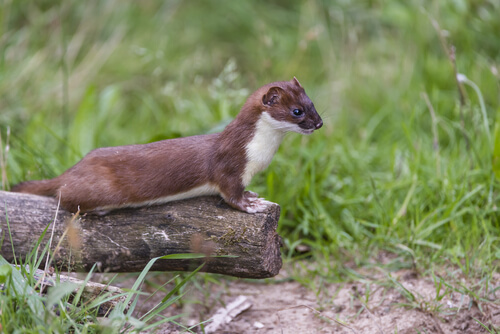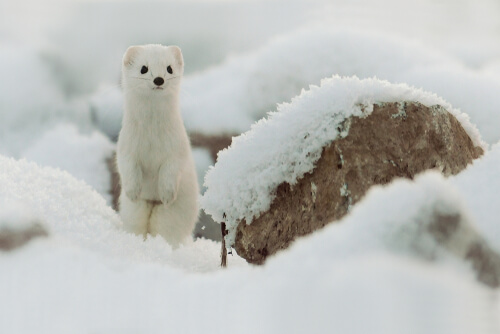The Stoat: Habitat and Behavior

The stoat is a small mammal with a circumpolar distribution. It’s popular because of its fur, which in the winter season turns as white as snow, allowing it to hide from its enemies. However, it’s a characteristic that makes it a coveted animal for humans.
Its scientific name is Mustela erminea and it belongs to the Mustelidae family. Besides being small, it’s a light and very fast animal. In this article, we’ll tell you all about the stoat, including all the interesting aspects of its biology, such as its habitat, physical characteristics, behavior, and conservation status. Let’s take a look at each of them.
Where does the stoat live?
The stoat is found in the circumpolar region of the Arctic, northern America, Asia and Europe, occupying diverse habitats. It prefers mixed forests, but can be found in a variety of locations from sea level to an altitude of 4050 meters (more than 13000 feet), including scrublands, alpine meadows, marshes, forest, and river edges.
Physical characteristics of the stoat
The stoat resembles a weasel. It has an elongated body with short limbs, a triangular-shaped head, rounded ears, and a long neck, as well as long whiskers. In addition, it has a tail that occupies about 35% of the total body length.
The stoat’s body measures an average of 16 to 33 centimeters long (6 to 12 inches). Being small animals, they’re also quite light, weighing no more than 350 grams (just over 12 oz). They exhibit sexual dimorphism (as do many other mustelids). This means that males are larger and heavier than females.
They have a short coat, which accentuates the color change of stoats that live in the coldest regions during the winter season. In winter they turn white, with black tail tips. In summer, they adopt a brown color on their backs, while they’re whitish or yellowish on the ventral region up to the lips.
Behavior
In general, stoats are territorial and solitary animals. They rarely tolerate the presence of other stoats in their territory, and especially those of the same gender. As a result, they aren’t seen in groups, except when they’re in mating season.
These animals use burrows, and they usually have several at the same time. In this way, they store food more easily and always have a home in case any of their burrows is taken by other animals.
Short-tailed weasels are dynamic both during the day and at night. Their activity periods range from 10 to 45 minutes, alternating with naps of 3 to 5 hours.
What does the stoat eat?
Stoats are omnivorous animals, although they have a preference for meat. Their main prey are mammals the size of rabbits or smaller. They often eat fruits, small rodents, birds, eggs, amphibians, fish, earthworms, and even some insects. In certain situations, they may also ingest carrion. However, they don’t prefer to eat carrion, and usually hunt their own food.
They have highly developed senses of sight, hearing, and smell, and these abilities allow them to hunt with ease. They also have very flexible and agile bodies. For this reason, they often climb high trees in search of small birds or eggs.
A study in Norway, published in the journal Mammal Research, in 2015, points out that these mammals are generalists in terms of their diet. Although they prefer to consume small rodents, they also ingest human food waste, as well as birds and insects.

How does the stoat reproduce?
A curious feature of the stoat is its reproductive cycle. The mating season is usually between April and May. However, the fertilized female won’t give birth until the following April. This is because her body pauses the development of the zygote at an early stage (blastocyst phase) for between 9 and 10 months. After this period, when the following spring arrives, gestation continues.
Thus, the total pregnancy time ranges from 223 to 378 days. After this period, from 3 to 18 offspring can be born, with 4 to 9 on average. As with American mink, females raise their young without the help of males.

Conservation status of the stoat
This type of mustelid isn’t endangered. According to the reports of the International Union for Conservation of Nature (IUCN), it is classified in the category of Least Concern. However, the main risk factors for its survival are habitat destruction and hunting. In places such as Russia, there’s limited trade in stoat fur.
Fur and exploitation
During the summer, the stoats’ fur is brown or honey-colored and the underside of their bodies is lighter. However, it’s during the winter that these coats become more coveted. In winter, they turn white to camouflage themselves. In both summer and winter, they have a black tail tip. It’s likely that this dark tip was an evolutionary product for survival purposes.
In Europe, the stoat’s winter coat was highly coveted by the nobility. Having a coat lined with this animal was a sign of wealth and power, as it was quite expensive. Today, there are farms for fur farming purposes. As with minks, stoats are bred for the commercialization of their fur and there are several protectionist groups fighting for their elimination.
We shouldn’t support the exploitation of the fur industry. Many animals suffer and die annually because of it.
The stoat, an interesting mammal
As you can see, stoats are very interesting mammals. The change in coloration of the fur according to the time of the year and the “pause” of their reproductive cycle are particularly interesting. We invite you to continue learning about other mustelid species, such as minks and weasels. You may also be surprised by some details of their biological makeup.
All cited sources were thoroughly reviewed by our team to ensure their quality, reliability, currency, and validity. The bibliography of this article was considered reliable and of academic or scientific accuracy.
- Dean, R., & Yamaguchi, N. (2020). Does the combination of embryonic diapause and superfoetation occur in the stoat Mustela erminea? A reinterpretation of existing data. Mammal Review, 50(4), 331-335. Recuperado de: https://onlinelibrary.wiley.com/doi/10.1111/mam.12217
- Erlinge, S. (1977). Spacing strategy in stoat Mustela erminea. Oikos, 28(1), 32-42. https://www.jstor.org/stable/3543320
- Erlinge, S., Sandell, M., & Brinck, C. (1982). Scent-marking and its territorial significance in stoats, Mustela erminea. Animal Behaviour. 30(3), 811-818. https://www.sciencedirect.com/science/article/abs/pii/S0003347282801541
- King, C., & Edgar, R. (1977). Techniques for trapping and tracking stoats (Mustela erminea); a review, and a new system. New Zealand Journal of Zoology, 4(2), 193-212. https://www.tandfonline.com/doi/abs/10.1080/03014223.1977.9517953
- Losso, H. (1999). Mustela erminea. Animal Diversity Web. Consultado el 15 de abril de 2023. https://animaldiversity.org/accounts/Mustela_erminea/
- Murphy, A. & Dowding, J. (1994). Range and Diet of Stoats (Mustela erminea) in a New Zealand beech forest. New Zealand Journal of Ecology, 18(1), 11-18. https://newzealandecology.org/nzje/1946
- Palazón, S., Salvador, A. (2017). Comadreja – Mustela nivalis (Linnaeus, 1761). Enciclopedia Virtual de los Vertebrados Españoles. Recuperado de: https://digital.csic.es/handle/10261/112367
- Piontek, A., Wierzbowska, I., Bevanger, K., & Tokarz, W. (2015). Comparison of the diet of stoat (Mustela erminea) in relation to sex and season in Norway. Mammal Research, 60, 301-307. Recuperado de: https://link.springer.com/article/10.1007/s13364-015-0237-x
- Reid, F., Helgen, K. & Kranz, A. (2016). Mustela erminea. The IUCN Red List of Threatened Species: e.T29674A45203335. Recuperado de: https://www.iucnredlist.org/species/29674/45203335
- Ruiz-Olmo, J. (2017). Armiño – Mustela erminea. En: Enciclopedia Virtual de los Vertebrados Españoles. Salvador, A., Barja, I. (Eds.). Museo Nacional de Ciencias Naturales, Madrid. Recuperado de: http://www.vertebradosibericos.org/mamiferos/muserm.html
